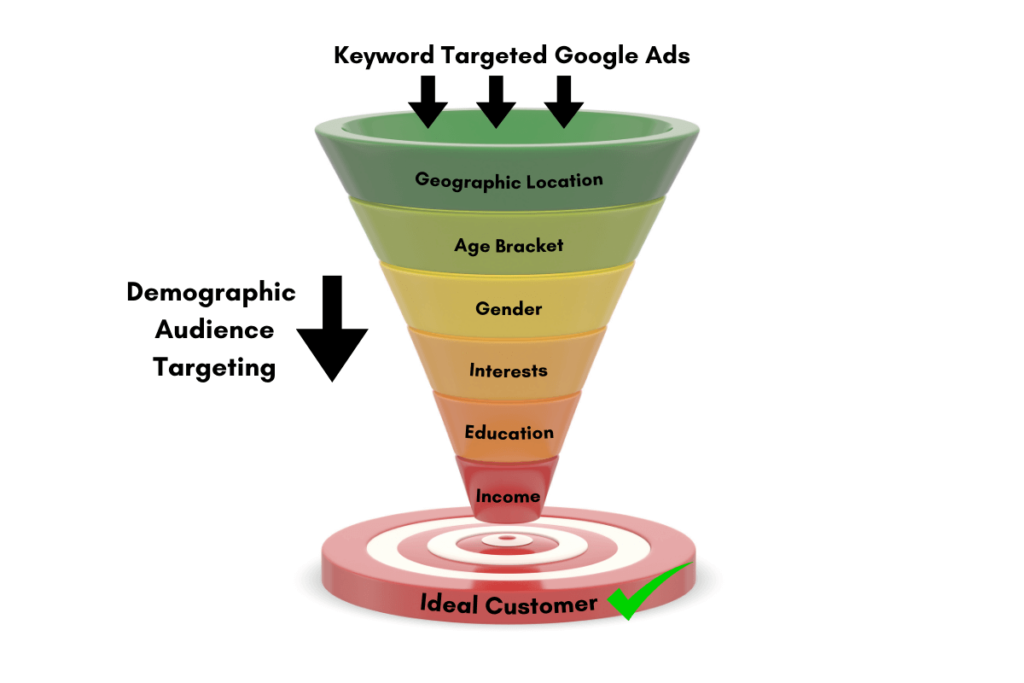Advertising online in this day and age has gone far beyond what we ever thought possible. Thanks to the precise, accurate tools for exact targeting through Google Ads and diverse demographic targeting strategies, businesses can zero in on their ideal audiences with unprecedented specificity.
Whether you’re looking to market across Australia or want to specify a certain region or area, knowing how to use Google Ads for demographic audience targeting is crucial to your business success. In this article, we’ll provide you with a comprehensive guide on how you can do just that.
What is Demographic Audience Targeting?
Demographic audience targeting is the practice of narrowing down your advertising focus based on various demographic factors like age, gender, location, income, and education level. Google Ads offers detailed demographic options, enabling you to craft campaigns targeted at specific groups of people who are more likely to be interested in your products or services.
This is different from keyword targeting, which focuses on the terms people use to search.
What’s the Difference Between Demographic Targeting and Keyword Targeting?
Both keyword targeting and demographic targeting are cornerstone tactics in digital advertising, particularly in platforms like Google Ads. However, they serve different purposes, offer different advantages, and are best suited for different kinds of campaign goals. Understanding these differences is crucial for anyone looking to run a successful advertising campaign.
Keyword Targeting
Keyword targeting involves selecting specific words or phrases relevant to your product or service. When users search for these terms in a search engine like Google, your ad is eligible to appear in the search results.
Advantages:
- High Relevance: By focusing on specific search terms, you’re targeting users who are actively interested in your product or service.
- Immediate Need: Users often search for terms when they have an immediate question, need, or intent to purchase.
- Budget Efficiency: Because you’re targeting high-intent users, the likelihood for conversion is generally higher, making it a cost-effective approach.
Limitations:
- Competitive: Popular keywords can be highly competitive and expensive.
- Complexity: Requires ongoing optimisation and an in-depth understanding of keyword research optimisation techniques to stay effective.
Demographic Targeting
Demographic targeting allows advertisers to focus on specific groups of people based on criteria like age, gender, income level, education, geographic location, etc. It’s less about what the user is currently searching for and more about who the user is.
Advantages:
- Audience Specificity: You can get extremely specific about who sees your ad, allowing for highly tailored messaging.
- Brand Alignment: By targeting specific demographics, you can ensure your brand is seen by individuals who align with its values or aesthetics.
- Cost Efficiency: By limiting the audience to specific demographics, you’re not wasting money on clicks from people unlikely to convert.
Limitations:
- Reduced Reach: By focusing on a specific demographic, you inherently limit the scope of your campaign.
- Data Dependency: The effectiveness of demographic targeting is highly dependent on the quality and accuracy of the demographic data available.
Keyword targeting is best for capturing users with high intent and immediate needs. It’s highly effective for sales-driven objectives but often requires a more substantial time investment for keyword research and ongoing optimisation. On the other hand, demographic targeting is ideal for long-term brand building and campaigns targeting a very specific audience. It’s generally easier to set up but requires high-quality data for maximum effectiveness.
Both methods have their own sets of advantages and disadvantages, and the best campaigns often use a mix of both keyword and demographic targeting strategies for maximum reach and effectiveness.

How Do I Target Specific Demographics with Google Ads?
To target specific demographics in Google Ads, you’ll first need to create a new campaign or edit an existing one. During the setup process, you’ll see the “Audiences” section where you can choose demographic options like:
- Age Groups: Choose among various age groups such as 18-24, 25-34, and so on.
- Gender: Target your ads based on gender – male, female, or unknown.
- Household Income: Particularly useful for high-value products, this lets you target by income percentile.
- Parental Status: Choose whether your audience are parents, not parents, or unknown.
- Geographic Location: From regions to specific postal codes, target based on geographical factors.
After selecting your target demographics, make sure to save your settings. Google Ads audience optimisation techniques suggest reviewing these settings periodically for best results.
What is the Best Target Audience for Google Ads?
The “best” target audience varies for each business and depends on the product or service being offered. It is important to build an audience for Google Ads that aligns with your business objectives. A successful Google Ads campaign doesn’t just reach a wide audience; it reaches the right one—your ideal audience in Google Ads.
Before launching a campaign, conduct thorough market research to understand who is most likely to benefit from your product or service. Is your product more popular among young adults? Does it cater to a luxury market, making household income a significant factor? Answering these questions will help you build the ideal audience for Google Ads campaigns.

What is Demographic Targeting Best Used For?
Demographic targeting is particularly useful for:
Product Specificity: If your product or service caters to a very specific demographic, this targeting ensures that only the most relevant eyes see your ad.
Geographical Considerations: For businesses operating in specific locations, like demographic targeting in Australia, honing in on geographic demographics can be especially beneficial.
Seasonal Campaigns: For products that cater to seasonal trends affecting particular demographics.
Upselling or Cross-Selling: Targeting existing customers with new offers based on their demographic profile.
Market Testing: If you’re launching a new product and want to test its appeal among different demographics.
Google Ads Demographics and Audience Optimisation
When it comes to Google Ads audience targeting, it’s not a ‘set it and forget it’ deal. Consistent review and adjustment of your demographic settings can lead to more effective campaigns. Google Ads provides analytics that help you understand how well you’re reaching your ideal audience. Use this data to refine your demographic targeting strategies continually.
Now that you better understand how to reach your ideal audience Google Ads, it’s time to take the next step. To successfully build audience for Google ads, you’ll need to go beyond the Google Ads Audience Targeting and consider things such as Campaign Goals and Interest Targeting among others. The end result will ensure that your demographic targeting will give you the best possible results from your Google Ads optimisation.
Not sure where to start? Reach out to our Adelaide-based Google Ads agency for a free consultation today!




